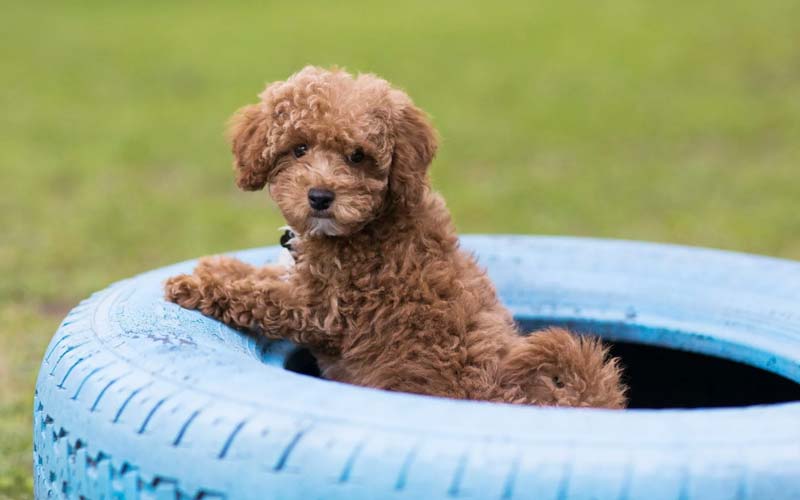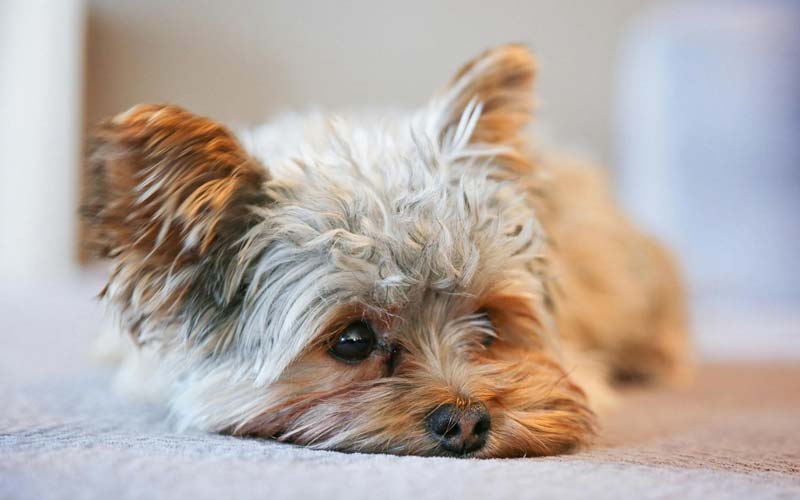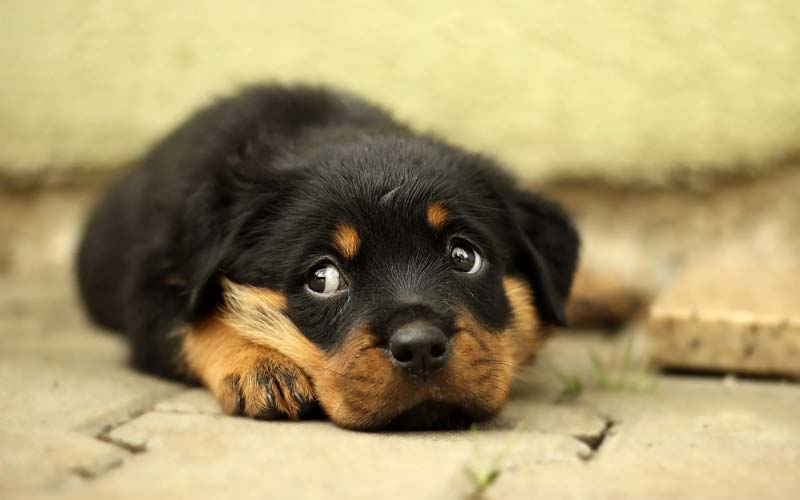If you have a new puppy, you may have noticed that they get very upset when you leave them alone. This is a common problem known as separation anxiety, and it can affect both your puppy’s happiness and your peace of mind. In this article, we will explain what separation anxiety is, how to recognize its signs and symptoms, and how to prevent and treat it effectively.

What is Separation Anxiety in Puppies?
Separation anxiety is a condition where a puppy becomes extremely anxious and distressed when separated from their owner or caregiver. It usually occurs when the puppy is left alone at home, but it can also happen when the owner is in another room or out of sight. Separation anxiety can cause a puppy to exhibit various behaviors that are harmful to themselves, the owner, or the environment.
Some of the common triggers for separation anxiety are:
- Being left alone for the first time or for longer than usual
- Moving to a new home or changing the routine
- Losing a family member or another pet
- Having a traumatic experience (e.g., a loud noise, a thunderstorm, a visit to the vet)
Signs and Symptoms of Separation Anxiety in Puppies
The most obvious sign of separation anxiety in puppies is their vocalization. They may bark, whine, howl, or cry excessively when left alone or when they sense that the owner is about to leave. This can be very annoying and disturbing for the neighbors, and it can also indicate that the puppy is suffering emotionally.
Other signs and symptoms of separation anxiety in puppies are:
- Destructive behavior: The puppy may chew, scratch, dig, or tear up objects, furniture, doors, or walls in an attempt to escape or to relieve their stress.
- Urination or defecation indoors: The puppy may lose control of their bladder or bowels due to anxiety, even if they are house-trained.
- Salivation or drooling: The puppy may salivate excessively due to nervousness, which can lead to dehydration or skin problems.
- Pacing or restlessness: The puppy may pace back and forth, run in circles, or try to follow the owner everywhere.
- Panting or trembling: The puppy may pant or shake due to fear or excitement.
- Self-injury: The puppy may lick, bite, or scratch themselves excessively, causing wounds or infections.
If you notice any of these signs in your puppy, you should consult your veterinarian to rule out any medical causes. Some of these behaviors can also be normal for puppies, especially when they are bored, hungry, or need attention. However, if they only occur when the puppy is alone or when the owner is leaving, they are likely related to separation anxiety.

Causes and Risk Factors of Separation Anxiety in Puppies
Separation anxiety in puppies can have various causes, depending on the puppy’s personality, history, and environment. Some of the possible causes are:
- Lack of socialization: Puppies need to be exposed to different people, animals, places, and situations during their critical socialization period, which is between 3 and 14 weeks of age. This helps them develop confidence and coping skills. If a puppy is isolated, neglected, or abused during this period, they may develop anxiety and attachment issues later on.
- Early weaning: Puppies should stay with their mother and littermates until they are at least 8 weeks old. This helps them learn social skills and independence from their mother. If a puppy is separated from their mother too early, they may become insecure and clingy to their owner.
- Breed predisposition: Some breeds are more prone to separation anxiety than others, due to their genetic traits or their original purpose. For example, breeds that were bred to work closely with humans, such as herding dogs, retrievers, or spaniels, may be more likely to develop separation anxiety than breeds that were bred to work independently, such as terriers, hounds, or spitzes.
Preventing Separation Anxiety in Puppies
The best way to prevent separation anxiety in puppies is to start training them from an early age. Here are some tips on how to prevent separation anxiety from developing:
- Gradual crate training: Crate training is a process of teaching your puppy to associate their crate with a safe and comfortable place, where they can relax and sleep. You can use the crate to confine your puppy when you are away, as long as you do it gradually and positively. Start by introducing the crate to your puppy with treats and toys, and let them explore it at their own pace. Then, close the door for a few seconds, and reward your puppy for staying calm. Gradually increase the duration and distance of your absence, until your puppy can stay in the crate for a few hours without distress.
- Desensitization to departure cues: Departure cues are the signals that your puppy learns to associate with your leaving, such as picking up your keys, putting on your shoes, or grabbing your coat. These cues can trigger anxiety in your puppy, so you need to desensitize them to them. You can do this by performing these cues randomly throughout the day, without actually leaving, and rewarding your puppy for staying calm. This way, your puppy will learn that these cues do not always mean that you are leaving, and they will become less anxious when you do.
- Socialization: As mentioned earlier, socialization is crucial for your puppy’s development and well-being. You should expose your puppy to different people, animals, places, and situations, in a positive and controlled manner. This will help your puppy become more confident and adaptable, and less dependent on you. You can also enroll your puppy in a puppy class, where they can learn basic obedience and social skills with other puppies and owners.
Treating Separation Anxiety in Puppies
If your puppy already has separation anxiety, you should seek professional help from a veterinarian, a trainer, or an animal behaviorist. They can assess your puppy’s condition and recommend a suitable treatment plan. Some of the common treatment methods for separation anxiety are:
- Behavior modification: This is a process of changing your puppy’s behavior through positive reinforcement and negative punishment. For example, you can reward your puppy for staying calm and quiet when you leave, and ignore or correct them for barking or whining. You can also teach your puppy to perform alternative behaviors, such as going to their bed or playing with a toy, when you leave.
- Counterconditioning: This is a process of changing your puppy’s emotional response to a stimulus, such as being alone, by pairing it with something positive, such as food or praise. For example, you can give your puppy a stuffed Kong or a puzzle toy filled with treats, when you leave, and take it away when you return. This way, your puppy will learn to associate being alone with something enjoyable, and reduce their anxiety.
- Desensitization: This is a process of gradually exposing your puppy to a stimulus, such as being alone, at a level that does not elicit anxiety, and increasing the intensity or duration as your puppy becomes more comfortable. For example, you can start by leaving your puppy alone for a few seconds, and returning before they get anxious. Then, you can increase the time by a few seconds, until your puppy can stay alone for a few minutes, and so on. You can also use a baby monitor or a camera to monitor your puppy’s behavior and reaction.

Additional Tips for Managing Separation Anxiety in Puppies
Besides the treatment methods mentioned above, here are some additional tips that can help you manage your puppy’s separation anxiety:
- Provide enrichment activities: You should provide your puppy with enough physical and mental stimulation, such as walks, playtime, training, or games, to keep them happy and tired. A tired puppy is a good puppy, and they will be less likely to be anxious or bored when you leave.
- Use calming aids: You can use some natural or synthetic products that can help calm your puppy, such as pheromones, aromatherapy, music, or supplements. However, you should consult your veterinarian before using any of these products, as they may have side effects or interactions with other medications.
- Be patient and consistent: You should understand that treating separation anxiety in puppies takes time and effort, and you should not expect immediate results. You should also be consistent with your training and treatment, and avoid any changes that may disrupt your puppy’s progress. You should also avoid scolding or punishing your puppy for their anxiety-related behaviors, as this will only make them more fearful and anxious.
Conclusion
Separation anxiety in puppies is a common and serious problem that can affect both your puppy’s happiness and your peace of mind. However, with proper training and care, you can prevent and treat this condition effectively, and help your puppy overcome their anxiety. Remember to seek professional help if your puppy’s separation anxiety is severe, and do not hesitate to contact us if you have any questions or concerns. We hope you found this article helpful, and we wish you and your puppy a happy and healthy life together.
